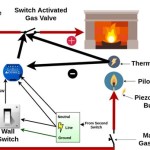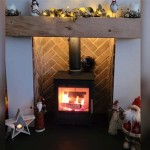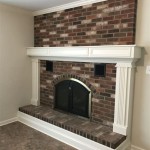Gas Fireplace Hood Vents: Functionality, Necessity, and Selection
Gas fireplaces offer an aesthetically pleasing and efficient heating solution for homes. However, their safe and effective operation relies heavily on proper ventilation. A crucial component in this ventilation system is the gas fireplace hood vent, often misunderstood or overlooked. This article delves into the purpose, function, selection criteria, and code compliance related to gas fireplace hood vents.
A gas fireplace hood vent, simply put, is a component designed to manage and redirect heat produced by a gas fireplace. It is typically a metal structure, usually made of steel or copper, installed above the fireplace opening. While some consider it solely an aesthetic addition, its functional role is more significant than mere decoration. Without a proper hood vent, excessive heat can accumulate, potentially damaging surrounding materials, affecting the unit’s performance, and even posing a safety hazard.
Understanding the Purpose of a Gas Fireplace Hood Vent
The primary purpose of a gas fireplace hood vent is multifaceted. It extends beyond simply capturing rising heat. It actively manages the thermal output of the fireplace, protecting the surrounding structure and ensuring user comfort. Here are the key functions:
Heat Deflection: The most obvious function is to deflect heat away from the wall above the fireplace. Concentrated heat can damage drywall, paint, wallpaper, and even structural elements over time. The hood acts as a barrier, dissipating the heat and preventing it from directly impacting these surfaces. This is particularly important for fireplaces with high BTU (British Thermal Unit) output, which generate significant amounts of heat.
Air Circulation Enhancement: A properly designed hood promotes better air circulation around the fireplace. By channeling the rising hot air, it can indirectly contribute to a more even distribution of heat throughout the room. This is especially beneficial in larger spaces where the fireplace might otherwise only heat a localized area. The hood encourages convective airflow, pulling cooler air in from below and pushing warmer air outwards.
Protection of Mantel and Surroundings: Mantels, whether made of wood, stone, or other materials, are susceptible to damage from prolonged exposure to high heat. The hood vent acts as a protective shield, preventing the mantel from overheating, warping, or discoloration. Similarly, it provides a buffer for artwork, electronics, or other decorative items positioned nearby, minimizing the risk of heat-related damage.
Prevention of Soot and Smoke Staining: Although gas fireplaces are designed to burn cleanly, incomplete combustion can occasionally occur, resulting in soot or smoke. A hood vent, particularly one with a wider projection, can help to capture and redirect these byproducts away from the wall, preventing unsightly staining. This is a less common concern with modern, well-maintained gas fireplaces, but the hood still provides an extra layer of protection.
Compliance with Building Codes: In many jurisdictions, the installation of a gas fireplace hood vent is mandated by building codes. These codes are in place to ensure the safe operation of the fireplace and to protect the building from potential fire hazards. Compliance with these regulations is not only a legal requirement but also a critical step in safeguarding your home and family.
Factors Influencing Hood Vent Selection
Choosing the right gas fireplace hood vent involves considering several key factors. These factors ensure that the selected vent not only complements the aesthetics of the fireplace but also provides the necessary level of protection and performance. The decision should be based on a thorough assessment of the fireplace's specifications and the surrounding environment.
Fireplace BTU Rating: The BTU rating of the gas fireplace is a primary determinant in selecting the appropriate hood vent. Fireplaces with higher BTU ratings generate more heat and require a larger, more robust hood to effectively manage the thermal output. Manufacturers typically provide recommendations for hood vent sizes based on the fireplace's BTU rating. Consulting these guidelines is crucial for ensuring adequate heat deflection.
Hood Size and Projection: The size of the hood vent, particularly its projection from the wall, directly impacts its ability to capture and redirect heat. A hood that is too small or has insufficient projection may not adequately protect the surrounding surfaces. The projection should be sufficient to cover the area above the fireplace that is most vulnerable to heat exposure. A general rule of thumb is to have the hood extend at least as far as the mantel, if a mantel is present.
Material and Finish: The material and finish of the hood vent should complement the overall aesthetic of the fireplace and the surrounding room. Common materials include steel, copper, and brass. Steel hoods are often powder-coated or painted to match the fireplace or other design elements. Copper hoods offer a classic and elegant look but may require periodic maintenance to prevent tarnishing. The chosen finish should be durable and resistant to heat and corrosion.
Style and Design: Hood vents are available in a variety of styles and designs, ranging from simple and functional to ornate and decorative. The chosen style should align with the overall design of the fireplace and the room. Considerations include the shape of the hood (e.g., straight, curved, angled), the presence of decorative elements (e.g., scrollwork, embossing), and the overall level of detail. A well-chosen hood vent can enhance the aesthetic appeal of the fireplace and serve as a focal point in the room.
Clearance to Combustibles: Building codes specify minimum clearances to combustible materials (e.g., wood, drywall) around the fireplace and the hood vent. It is essential to ensure that the selected hood vent meets these clearance requirements. Insufficient clearance can create a fire hazard. Consult local building codes and the fireplace manufacturer's instructions to determine the appropriate clearances.
Ventilation Requirements: The overall ventilation system of the fireplace, including the chimney or flue, should be considered when selecting a hood vent. The hood should not impede the proper functioning of the ventilation system. In some cases, a specialized hood vent may be required to address specific ventilation challenges.
Code Compliance and Installation
Adherence to local building codes is paramount when installing a gas fireplace and its associated hood vent. These codes are designed to protect occupants and property from fire hazards. Proper installation is equally important, as even the best hood vent will be ineffective if installed incorrectly.
Understanding Local Codes: Building codes vary significantly from one jurisdiction to another. It is crucial to consult the local building department or a qualified inspector to determine the specific requirements for gas fireplace installations in your area. These codes may specify the type of hood vent required, the minimum clearances to combustibles, and other relevant details. Failure to comply with these codes can result in fines, delays, and even the denial of occupancy permits.
Professional Installation: While some homeowners may attempt to install a gas fireplace hood vent themselves, professional installation is strongly recommended. Qualified installers have the knowledge and experience to ensure that the hood vent is properly sized, positioned, and secured. They can also verify that the installation complies with all applicable building codes. Furthermore, improperly installed gas appliances can pose a significant safety risk, including carbon monoxide poisoning or fire. Using a certified installer mitigates these risks.
Proper Sizing and Placement: The hood vent must be properly sized and placed to effectively capture and redirect heat. The size of the hood should be appropriate for the BTU rating of the fireplace, as discussed earlier. The placement of the hood should be such that it effectively shields the surrounding surfaces from heat exposure. The hood should be securely attached to the wall or fireplace surround, using appropriate fasteners. Ensuring secure and stable installation is key for long-term performance and safety.
Clearances to Combustibles: As previously mentioned, maintaining adequate clearances to combustible materials is critical. The hood vent should be positioned so that it does not come into contact with or excessively heat any combustible materials, such as wood framing, drywall, or curtains. Follow the manufacturer's instructions and local building codes to determine the minimum clearance requirements. Heat shields may be necessary in some cases to further protect combustible materials.
Inspection and Certification: After installation, it is advisable to have the gas fireplace and hood vent inspected by a qualified professional. The inspector can verify that the installation is safe and compliant with all applicable codes. In some jurisdictions, a formal certification is required to ensure that the fireplace is safe to operate. This inspection provides peace of mind and helps to prevent potential problems in the future.
In summary, the gas fireplace hood vent plays a vital role in the safe and efficient operation of a gas fireplace. It manages heat, protects surrounding materials, and ensures compliance with building codes. Proper selection, installation, and maintenance of the hood vent are essential for maximizing its benefits and minimizing potential risks. Understanding the purpose of the hood vent, considering the relevant factors influencing selection, and adhering to code compliance guidelines are key to a successful and safe gas fireplace installation.

How Fireplace Hoods Protect Your Hearth From Heat Damage

24 Gauge Steel Fireplace Hood Made To Custom Specifications

Fireplace Hoods Heat Deflectors Custom

Canopies And Fire Hoods Camelot Fireplace Open

Canopies And Fire Hoods Camelot Fireplace Open

Fireplace Hoods Heat Deflectors Custom

Fireplace Hood Canopy Or Heat Deflector Project Small House

Custom Case Study Fire Pit With A Suspended Hood Vancouver Gas Fireplaces

Empire 28 To 48 Inch Adjustable Fireplace Hood Heat Deflector Kit

Empire Fireplace Hood
Related Posts








